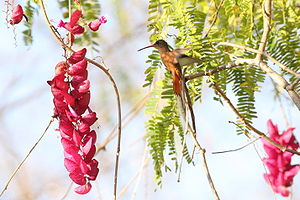Cinnamon belly amazil
| Cinnamon belly amazil | ||||||||||
|---|---|---|---|---|---|---|---|---|---|---|

Cinnamon belly amazilie ( Amazilia rutila ) |
||||||||||
| Systematics | ||||||||||
|
||||||||||
| Scientific name | ||||||||||
| Amazilia rutila | ||||||||||
| ( Delattre , 1843) |
The cinnamon- bellied amazilie ( Amazilia rutila ), sometimes also called rust- amazilia or rust-amazilie , is a species of bird in the hummingbird family (Trochilidae). The species has a large range that covers about 350,000 square kilometers in the Central American countries Belize , Costa Rica , Guatemala , Honduras , Mexico , El Salvador and Nicaragua, as well as the United States . The IUCN assesses the population as Least Concern .
features
The cinnamon belly amazily reaches a body length of about 10 to 11.5 centimeters. The coral-red beak is between 19 and 24 millimeters long. The tail is red-brown and reaches a length between 31 and 37 millimeters. The relatively large hummingbird is particularly characterized by its cinnamon-colored underside. The crown, the neck and the top are light green, a color that merges into the greenish-bronze colored in the rear part up to the rump . Males and females are very similar in their plumage and behavior. There are minor color differences with regard to the beak.
behavior
The bird is relatively aggressive when it comes to defending its territory and the associated sources of nectar against other hummingbirds or insects. The breeding season is between November and February or June and July. In the west of Mexico, the cinnamon-bellied amacilas also breed in September. The goblet-shaped, well-camouflaged nests are built from thin plant fibers, feathers and animal hair.
Habitat
The cinnamon belly amazil is found in forests of the lowlands and middle altitudes. The bird prefers bushy ground in pine forests, but also in coastal areas. Since the hummingbird has adapted well to human cultural landscapes, it can also be observed in gardens, parks and plantations.
Subspecies
So far, the following four subspecies are known:
- Amazilia rutila corallirostris ( Bourcier & Mulsant , 1846)
- Amazilia rutila diluta van Rossem , 1938
- Amazilia rutila graysoni Lawrence , 1867
- Amazilia rutila rutila ( Delattre , 1843)
The subspecies diluta is found in northwestern Mexico in the states of Sinaloa and Nayarit . The subspecies graysoni can be found on the Marias Islands . In the west and southwest of Mexico, in the states of Jalisco and Oaxaca , one encounters the ssp. rutila . The spp. corallirostris occurs from the south and southeast of Mexico, in the states of Chiapas and Yucatán , to Costa Rica.
Etymology and history of research
Adolphe Delattre described the cinnamon bellies under the name Ornismya rutila . The type specimen was collected by Pierre Adolphe Lesson (1805–1888), the brother of René Primevère Lesson , in Acapulco . Later the species was assigned to the genus Amazilia . This word comes from a novel by Jean-François Marmontel , who reported in Les Incas, Ou La Destruction De L'empire Du Pérou, about an Inca heroine named Amazili. The species name (lat. »Rutilus« for »golden reddish, golden brown«) refers to the color of the plumage. The names of the subspecies are derived from the beak color ("corallirostris" from Latin "corallinus" for "coral red" and "rostrum" for "beak") and from the overall impression ("diluta" for "pale, bright, diluted"). The name "graysoni" is dedicated to Colonel Andrew Jackson Grayson (1819–1869), who collected the type specimen in Mazatlán .
literature
- Sheri L. Williamson, Roger Tory Peterson: A Field Guide to Hummingbirds of North America . Houghton Mifflin, Boston, Massachusetts 2002, ISBN 978-0-618-02495-7 .
- H. Lee Jones, Dana Gardner: Birds of Belize . Christopher Helm Publishers Ltd, London 2004, ISBN 978-0-7136-6760-8 .
- James A. Jobling: Helm Dictionary of Scientific Bird Names . Christopher Helm, London 2010, ISBN 978-1-4081-2501-4 .
- Adolphe Delattre : Oiseaux-Mouches nouveaux au peu connus, découverts au Gualimala . In: L'Echo Du Monde Savant (= 2 ). tape 7 , no. 45 , 1843, pp. 1068-1070 .
- Jules Bourcier, Étienne Mulsant: Description of the vingt espèces nouvelles d'oiseaux-mouches . In: Annales des sciences physiques et naturelles, d'agriculture et d'industrie . tape 9 , 1846, pp. 312-332 ( online [accessed February 3, 2014]).
- George Newbold Lawrence: Descriptions of Six New Species of Birds of the Families Hirundinidae, Formicardiae, Tyrannidae, and Trochilidae . In: Annals of the Lyceum of Natural History of New York . tape 8 , 1867, p. 400–405 ( online [accessed February 3, 2014]).
- Adriaan Joseph van Rossem: A Northwest Race of the Cinnamon Hummingbird . In: The Condor . tape 40 , no. 5 , 1938, pp. 226–227 ( online (PDF; 195.66 kB) [accessed on February 3, 2014]).
Web links
- Amazilia rutila inthe IUCN 2013 Red List of Threatened Species . Listed by: BirdLife International, 2012. Retrieved February 11, 2014.
- BirdLife International: Species Factsheet - Cinnamon Hummingbird ( Amazilia rutila ) . Retrieved February 11, 2014.
- Videos, photos and sound recordings for Cinnamon Hummingbird (Amazilia rutila) in the Internet Bird Collection
- Cinnamon belly amazilia ( Amazilia rutila ) at Avibase; Retrieved January 7, 2012.
- Amazilia rutila in the Integrated Taxonomic Information System (ITIS). Retrieved January 7, 2012.
- xeno-canto: Sound recordings - Cinnamon Hummingbird ( Amazilia rutila )
Individual evidence
- ↑ Sheri L. Williamson et al., Pp. 158f
- ↑ H. Lee Jones et al., Pp. 139f
- ^ IOC World Bird List Hummingbirds
- ↑ Jules Bourcier et al. a., p. 328
- ^ Adriaan Joseph van Rossem, p. 226
- ↑ a b George Newbold Lawrence, p. 404
- ↑ a b Adolphe Delattre, p. 1069
- ↑ James A. Jobling p. 43
- ↑ James A. Jobling p. 344
- ↑ James A. Jobling, p. 118
- ↑ James A. Jobling p. 136
